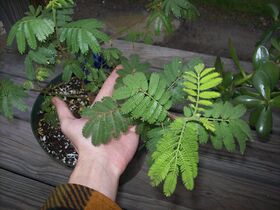Mimosa tenuiflora
| Mimosa tenuiflora | |
|---|---|
| Taxonomical nomenclature | |
| Kingdom | Plantae |
| Unranked | Angiosperms |
| Unranked | Eudicots |
| Unranked | Rosids |
| Order | Fabales |
| Family | Fabaceae |
| Genus | Mimosa |
| Species | tenuiflora |
| Common nomenclature | |
| Synonyms | Mimosa hostilis |
| Common names | Jurema Preta, Calumbi, Tepezcohuite, Carbonal, Cabrera |
| Constituents | |
| Active constituents | DMT |
Mimosa tenuiflora (also known as Mimosa hostilis and Jurema) is a perennial shrub indigenous to northeast South America, more commonly in lower altitudes. The dried root bark may contain up to 1.0 to 1.7% DMT[1]
It has been used by indigenous peoples of South America for use in Ayahuasca brews. It is typically combined with Banisteriopsis caapi or another plant source of beta-carboline MAOIs (specifically Reversible Inhibitors of MAO-A, or RIMAs such as the Harmala alkaloids).[2] It is also used as a source of DMT for extraction in modern times, and as an admixture for ayahuasca brews in both ancient and modern contexts.
Although no beta-carbolines have been detected in M. tenuiflora samples, it exhibits psychoactivity when taken alone, suggesting an alternate mechanism than the DMT it contains, which would otherwise be rapidly metabolized by the MAO-A enzyme, rendering it virtually inactive (at least from its DMT content).[citation needed]
Chemistry
In 2005 the alkaloid Yuremamine was isolated from root bark samples, and is considered the first compound in a new family of of phytoindole compounds.[3]
Gallery
Legal status
Internationally, DMT is a Schedule I drug under the Convention on Psychotropic Substances. The Commentary on the Convention on Psychotropic Substances notes, however, that the plants containing it are not subject to international control:[4]
"The cultivation of plants from which psychotropic substances are obtained is not controlled by the Vienna Convention. . . . Neither the crown (fruit, mescal button) of the Peyote cactus nor the roots of the plant Mimosa hostilis nor Psilocybe mushrooms themselves are included in Schedule 1, but only their respective principals, mescaline, DMT, and psilocin."
External links
References
- ↑ Rätsch, C. (2005). The encyclopedia of psychoactive plants: ethnopharmacology and its applications. Park Street Press. ISBN 9780892819782.
- ↑ Ott, J. (1994). Ayahuasca analogues: Pangæan entheogens (1st ed. ed.). Natural Products Co. ISBN 9780961423445.
- ↑ Vepsäläinen, J., Auriola, S., Tukiainen, M., Ropponen, N., Callaway, J. (October 2005). "Isolation and Characterization of Yuremamine, a New Phytoindole". Planta Medica. 71 (11): 1053–1057. doi:10.1055/s-2005-873131. ISSN 0032-0943.
- ↑ DMT – UN report, MAPS, 2001-03-31, archived from the original on January 21, 2012, retrieved 2012-01-14
